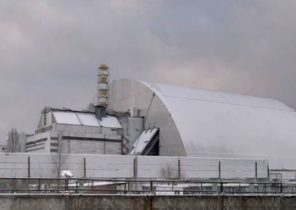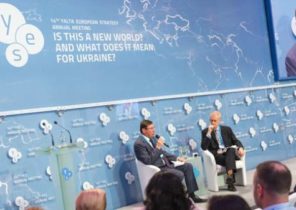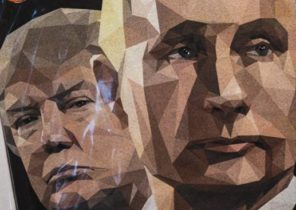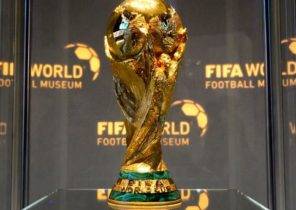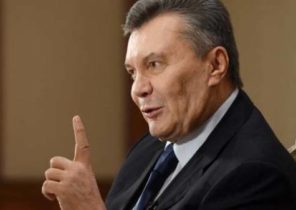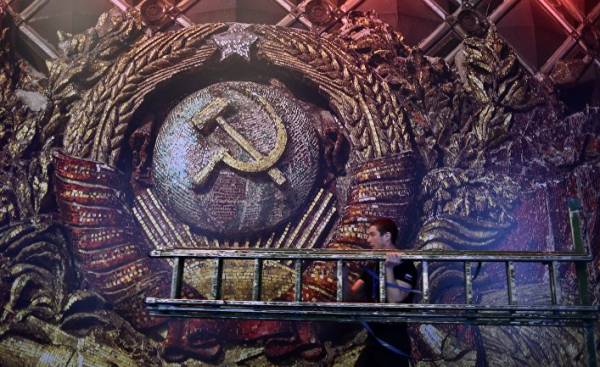
Occurred in December 1991, the collapse of the Soviet Union was probably one of the most amazing and pivotal events of the 20th century. Unexpected at the time the end of the cold war led to the birth of a new world, new opportunities and challenges. Despite the eighteen-month process that led to the collapse of the Soviet Union in December 1991, the collapse of the mighty Communist superpower caught many by surprise — both in the U.S. and the Soviet Union. Russian President Vladimir Putin considered the fall of the Soviet Union “the greatest geopolitical catastrophe of the 20th century”.
However, was the collapse of the Soviet Union inevitable? In our days it is well known that by the end of 1991 to preserve the USSR in the form in which it existed decades after 1922, it was impossible. According to now believe that political, economic and socio-cultural processes taking place in the country since 1986, eventually, tore her apart, and relatively quick end to the largest country on the planet was preferable to other possible outcomes. However, the Soviet government tried to prolong the existence of their own country, using new approaches in its management. In Russia, still continues the discussion of plausible alternatives that happened and Russian politicians, the intelligentsia and the nationalists are trying to understand whether it was possible to do something to keep the country intact, and whether there was a need for that. Will we be able to find the answer to this question, carefully studied prior to the collapse of the Soviet Union?
What happened
The Soviet Constitution included article 72, according to which were part of a Republic had the right to secession. However, let’s be honest — if that was true, this process would have started long before 1990. The Soviet government would never have allowed the republics to leave their own country as independent entities. Such would lead to the weakening of the Soviet state in the “zero-sum game”, which was the cold war.
All 15 Soviet republics were interrelated complex matrix of economic relations, through which the Russian Soviet Federative socialist Republic was at the center of all important industrial, economic and political processes of the country. We are still faced with the remnants of this system in the complex relationships between Russia and Ukraine. Even in the midst of the war between the two countries, the Russian forces continue to rely on the military products of Ukrainian industry and Ukrainian plants and industrial enterprises earn by selling their technology to the Russians. Only recently, Moscow has announced that starting in 2018 will be ready to “import substitution” of the Ukrainian military products. The Soviet Union kept its vast regions and the Republic together with a system of subsidies and economic fixed quota, which less developed regions received Soviet technology and consumer products in exchange for raw materials and agricultural products. In some cases, Moscow has offered as finished products and raw materials in order to compensate for an insufficiently developed industrial base in some regions.
When the Soviet economy has shown signs of significant decline in the 1980s, the population of the USSR and many of his legislators were worried. The recent course of political freedom and transparency has unleashed forces that rocked the legitimacy of the ruling Communist party and undermined the Foundation of the state. Fast forward to 8 December 1991. The disintegration of the country became possible thanks to the so-called Belovezhskoe agreement signed in Belarus. The heads of three Soviet republics — Russia, Ukraine and Belarus signed the document formally ending the existence of the USSR. When the signing was made to the previously mentioned article 72 of the Constitution, which allowed a “peaceful” exit from the country. It should be noted that this decision was taken without considering the opinion of the population living in the dark for the preceding months. While the shock of what happened in the Bialowieza forest still echoed around the world, December 21, there was a new meeting, this time in the capital of Kazakhstan, Alma-ATA. There the heads of 11 Soviet republics (except Georgia and the Baltic States) finally disbanded what was left of the Soviet Union. No doubt, this second meeting was made possible by its predecessor, the Belavezha agreement, which laid a legal basis and final precedent for further and irreversible collapse of the USSR. 25 Dec 1991, a kind of Christmas gift was for the United States and its allies launched in the Kremlin, the Soviet flag, change the current Russian tricolor and heralded the end of the cold war and the emergence of a new and unpredictable world.
That could happen
It is now clear that the majority of Soviet citizens wanted to save the USSR in one form or another. However, this requires a different paradigm of governance and more decisive government ready to eliminate competition from alternative political or ethnic models. Before the putsch of August 1991, fatally weaken the then Soviet President Mikhail Gorbachev and resulted in Boris Yeltsin’s presidency, the Soviet authorities were discussing the merits of a Union of Sovereign States (SSG). On 17 March 1991 in nine Soviet republics — Russia, Ukraine, Belarus, Kazakhstan, Azerbaijan, Uzbekistan, Kyrgyzstan, Turkmenistan and Tajikistan — was held a popular referendum. The majority of voters supported the preservation of the Soviet Federal system. 23 April 1991, following a referendum, the Central Soviet government signed with the nine republics of the agreement under which the Soviet Union had become a Federation of independent republics with a common President, common foreign policy and army. Hard to say how would work this agreement in fact, given what was happening across the country large-scale political and social changes. By August 1991 all nine of the republics except Ukraine approved the draft of the new agreement. Unfortunately for Gorbachev, the Soviet conservatives in August 1991, a coup finally removed him from the political scene and put an end to further attempts to reform the country.
If it was possible?
Perhaps the idea of SSG, and was viable, however, its advance was undermined by the same political forces that tore apart the Soviet Union. In 1986, Gorbachev began two processes, eventually leading to the destruction of the country under his leadership. Glasnost meant political transparency, while restructuring meant political and economic reorganization. Although their task was the gradual liberalization of certain elements of governance and interaction with the public, both weakened the ability of the Soviet authorities to control and supervision, leading to political and economic chaos, as well as the growth of nationalist and separatist tendencies in many countries. Probably, in the light of these developments, the participants of the Belavezha agreement considered their actions is inevitable, and therefore justified. But what if Gorbachev implemented reforms differently? What if the Communist party of the Soviet Union started the liberalisation of the Soviet economy, while maintaining rigid control over political ideology?
These measures already had a precedent. In 1921, following the victory of the Soviet authorities over turistami and anti-Bolshevik forces in the civil war of 1918-1920, was introduced the new economic policy (NEP). While the country’s economy was in ruins, the government has permitted private enterprises to coexist with the nascent state of the industry. Albeit with varying degrees of success, the NEP led to almost complete recovery of the national economy to the level preceding the First world, until it suddenly swerved in 1928 Stalin. One can only wonder about the possible fate of the Soviet Union if the NEP was allowed to continue. Small industry and agriculture belong to the private sector. “Reference height” of the economy such as heavy industry and mines, would be controlled by the state. If it is similar to modern China, possibly because it is — the Chinese economic miracle has occurred under the strict control of the Communist party who could not tolerate dissent.
Such a scenario has played out in the late 1980s, Gorbachev would have to convince his supporters that his new policy would not undermine her position and reputation. In fact, in the late 1980s, the cynicism and distrust of the Soviet population to party slogans and management reached a peak. The loss of confidence in the ability of the government how to govern the country and to protect the interests of citizens caused an increase in alternative ideologies and movements, leading eventually to the Belovezhskaya and the Alma-ATA agreements. But what if Gorbachev failed to convince their colleagues that improving the economic situation in the Soviet Union would lead to the restoration of public confidence in the party and the state? The outcome of the March 1991 vote showed that many Soviet citizens still wanted to live in a single state. Updated economic plan would leave medium and large enterprises in state hands, while allowing the population to engage in small economic activities, especially in the field of agriculture. In such a scenario, there would be places of openness, and open criticism of the state, recognition of the dark Soviet past and the rise of ethnic nationalism in the outlying republics. The Soviet government would open for the nascent business class access to small business loans, allowing its most successful representatives in the party that would enable the government to interact with the most enterprising citizens. Such a purely economic approach would have redirected the energy of many people from anti-government activities and protests in earnings, as it later happened in China, though with some notable exceptions. In the mid-80s the Soviet society was ready for such progressive economic change, and would make more economic freedom. However, all this is based on the assumption that the state would be able to successfully conduct such an economic transformation. A tempting idea that, despite the many flaws of the Soviet system, the lack of meaningful political competition Gorbachev would gradually reforming the Soviet Union to overcome their internal problems and relive 1991 in the renovated and restored to health. Don’t be separatist movements in the Baltic States and the Caucasus, and not been for the August coup, a plan for the economic liberalization of the Soviet Union could succeed.
New Alliance?
Would the newness of this country to compete effectively on the world stage with the United States, Western Europe and the growing power of China? Perhaps after years and decade, the Soviet Communist party began to liberalisierten, as is happening in China, which is aggressively trying to reinvent the Communist ideology to the beat of a developing society. Turned to this new Alliance (for brevity let’s call it “NS”) their numerous international commitments, in order to save resources and money? It is quite possible that this would have happened, and the subsequent recovery of Eastern Europe from the Warsaw Pact. Could also be necessary in failure of the new Union from active participation in African and Latin American politics — although if this new Soviet Union would be able to carry out economic reforms, similar to those in 1928, in the end the West would have faced a powerful and United Soviet state seeking to preserve its place as a competitive superpower.
Similarly, it is difficult to predict how the HC interacted with a rising China, as he was to him a direct competitor in the role of overseer of the Communist liberaliseerimine economy. Perhaps they would be able to reach an understanding, given the similarities in their governance. Given the countries that have adopted or are contemplating on getting adopt the Chinese model of state capitalism in 2017, it is easy to imagine the emergence of a Soviet model of state capitalism as a competitor to American, Western European and Chinese. However, for the survival of the national Assembly after the 1990s, it would take a confident and strong Communist government that is prepared to make difficult decisions for the public good. The Chinese were forced to make such election in 1989, when the army crushed the Pro-democracy protests in Tiananmen square. In addition, the success of the NEP in the 1920s was made possible thanks to the entrepreneurial class, the survivors of the October revolution and the Civil war. However, by the 1980s, these people and their business experience has long gone, and the Soviet authorities lacked expert level sufficient for success in a free market.
Today it is considered that, despite the willingness of Gorbachev to use violence to suppress the protests in the Baltic States, he would be unable to hold the country together through force alone. Maybe he was in the right place at the wrong time — he come to power later, when NS tried to make the transition to state capitalism, his talents and vision could make him a good Manager. It is also worth noting that, despite the subsequent 1991 euphoria among the Western world, the collapse of the USSR was not predetermined. The events of December 1991 caught most experts and analysts by surprise. Therefore, if NA survived, he would have faced the same hostile policy on the part of America and NATO, designed to deter Moscow. Despite the gradual introduction of a market principles, the national Assembly would remain a Communist state, for which the reforms would be a reasonable step towards a global confrontation with the West.
Probably to save the Soviet Union was impossible, given the circumstances in which the country found itself by the end of 1980s. At that time, its internal mechanisms and policy processes has hampered the embodiment of even those decisions, which was according to the majority. The idea of a reformed Soviet Union could be continued to our days in the form of a series of economic, military and political alliances concluded by Russia (the official successor of the USSR) with the former Soviet republics in the neighborhood. The Eurasian economic Union, which includes Russia, Belarus, Kazakhstan, Armenia and Kyrgyzstan, as well as close ties between the Russian and Armenian armed forces are reminiscent of the Soviet legacy. Perhaps the Soviet Union was not destined to remain intact, but the questions and assumptions about his possible fate will continue to occupy us in the years to come.


